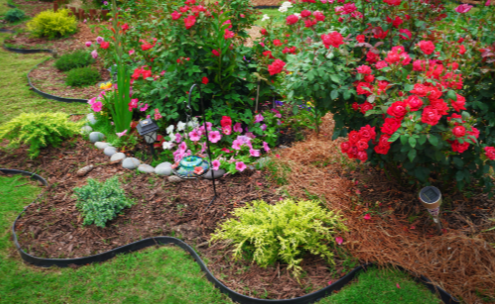
The Difference Between Plastic, Metal, and Concrete Landscape Edging
Landscape edging plays a big role in how polished and long-lasting your yard looks. It defines garden beds, keeps grass and mulch in place, and adds structure to your outdoor design. With so many edging materials available, choosing the right one can be confusing. The most common options are plastic, metal, and concrete, and each offers unique benefits and drawbacks depending on your goals and budget.
Here’s how these three types of edging compare and how to decide which is best for your home.
Plastic Landscape Edging
Pros:
Plastic edging is affordable, lightweight, and easy to install. It’s a popular choice for quick weekend projects or for homeowners looking to create simple borders around flower beds or trees. The flexibility of plastic allows it to curve easily, making it great for gardens with rounded shapes or irregular designs.
Cons:
While cost-effective, plastic edging is not the most durable option. Over time, exposure to sunlight and weather can cause it to fade, crack, or warp. It can also shift out of place as the soil settles or expands with temperature changes. Plastic edging works best for temporary projects or small gardens where appearance and long-term performance are less critical.
Metal Landscape Edging
Pros:
Metal edging offers a sleek, modern look that works beautifully in both residential and commercial landscapes. It provides crisp, clean lines that create a professional appearance. Steel and aluminum are the most common materials, with steel offering more strength and aluminum resisting rust better.
Cons:
Although it lasts longer than plastic, metal edging can be more expensive and time-consuming to install. It also requires extra care around children and pets, as the edges can be sharp. Over time, metal edging may rust or discolor if not properly maintained. Still, for homeowners seeking a minimalist design with durability, metal is an excellent choice.
Concrete Landscape Edging
Pros:
Concrete edging combines beauty, strength, and permanence. It is custom installed on-site, allowing for endless design options including stamped patterns, color variations, and flowing curves. Unlike plastic or metal, concrete edging doesn’t shift, rust, or deteriorate over time. It provides a strong barrier that keeps mulch, rocks, and soil neatly contained while preventing grass from creeping into garden beds.
Cons:
Concrete edging requires professional installation and a higher initial investment, but it offers unmatched longevity. When installed correctly, it can last for decades with minimal maintenance, making it a worthwhile upgrade for homeowners who value durability and aesthetics.
Companies like Alpine Curbing specialize in decorative concrete landscape edging that enhances curb appeal and stands up to Utah’s varying weather conditions. Their craftsmanship and attention to detail ensure that every project not only looks beautiful but also lasts for years to come.
Choosing the Right Material for Your Landscape
If you’re looking for something affordable and temporary, plastic edging may do the trick. For a sleek, modern style with long-term durability, metal edging could be the right choice. However, if you want a permanent solution that boosts curb appeal and requires little upkeep, concrete edging offers the best overall value.
The right edging material depends on your budget, design goals, and how much maintenance you’re willing to handle. Investing in a long-lasting solution like concrete can save time, money, and effort in the long run while transforming the overall look of your yard.




